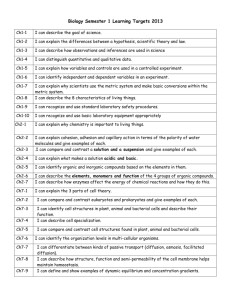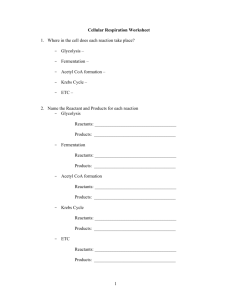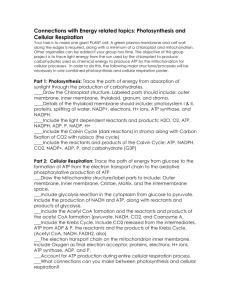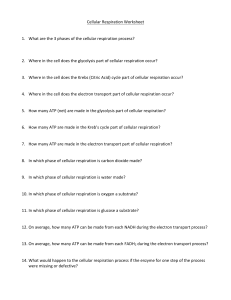Criteria
advertisement
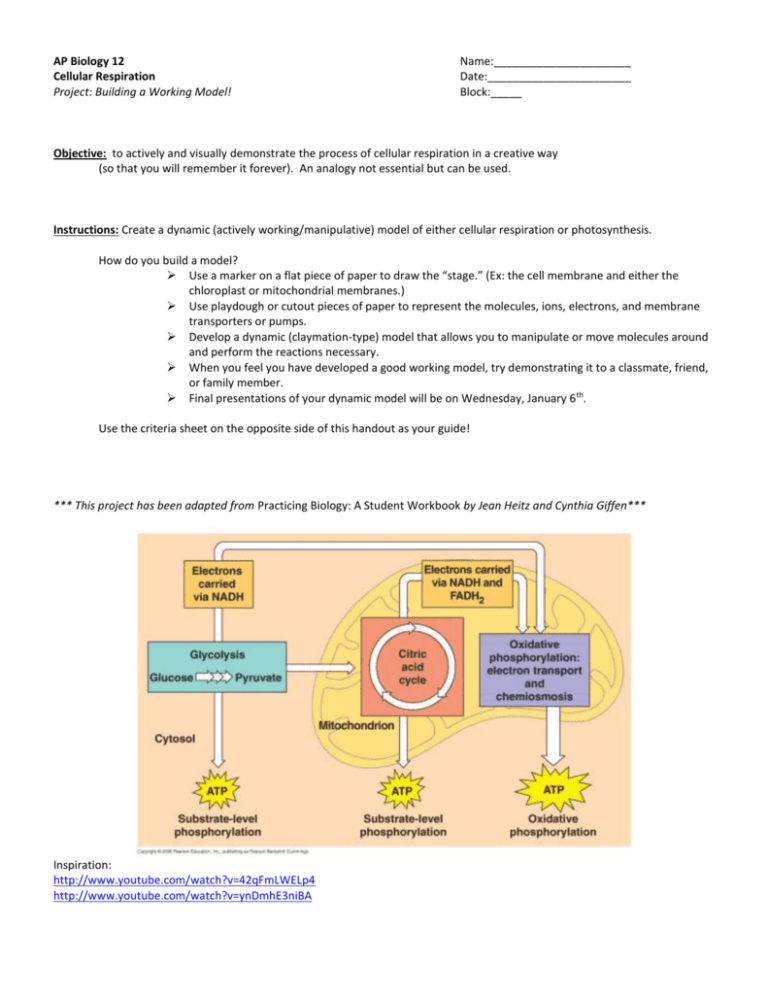
AP Biology 12 Cellular Respiration Project: Building a Working Model! Name:______________________ Date:_______________________ Block:_____ Objective: to actively and visually demonstrate the process of cellular respiration in a creative way (so that you will remember it forever). An analogy not essential but can be used. Instructions: Create a dynamic (actively working/manipulative) model of either cellular respiration or photosynthesis. How do you build a model? Use a marker on a flat piece of paper to draw the “stage.” (Ex: the cell membrane and either the chloroplast or mitochondrial membranes.) Use playdough or cutout pieces of paper to represent the molecules, ions, electrons, and membrane transporters or pumps. Develop a dynamic (claymation-type) model that allows you to manipulate or move molecules around and perform the reactions necessary. When you feel you have developed a good working model, try demonstrating it to a classmate, friend, or family member. Final presentations of your dynamic model will be on Wednesday, January 6 th. Use the criteria sheet on the opposite side of this handout as your guide! *** This project has been adapted from Practicing Biology: A Student Workbook by Jean Heitz and Cynthia Giffen*** Inspiration: http://www.youtube.com/watch?v=42qFmLWELp4 http://www.youtube.com/watch?v=ynDmhE3niBA AP Biology 12 Cellular Respiration Project: Building a Working Model! Name:______________________ Date:_______________________ Block:_____ Assessed By: ___________________________ Performance-Based Assessment: Beginning Content – Many of the Structure components are missing or incorrectly used Developing The majority of structural components are correctly used, while some components are missing or incorrect Accomplished Almost all structural components are correctly used, with some minor errors. Exemplary All structural components are correctly used mitochondrion with both membranes, cristae, cytosol, glucose, oxygen, carbon dioxide, water, pyruvate, acetyl CoA, NAD+, NADH, FAD, FADH2, electrons (e-), H+, ADP, Pi, ATP, ATP synthase Content – Many processes are The majority of Almost all processes Entire process is correct Process incorrect or not processes are correct are correct and and accurate included. and accurate, with accurate, with some some processes minor errors. missing or incorrect Glycolysis: location (cytosol), energy investment, energy payoff, net energy and electron carrier, main reactants and products Citric Acid Cycle: location (mitochrondrial matrix), preparation (making acetyl coA), showing 2 cycles, net energy and electron carriers, main reactants and products Oxidative Phosphorylation Electron transport chain: location (mitochondrial inner membrane), creation of proton motive force (movement of H+), transportation of electrons until the last reduction, net energy and electron carriers, main reactants and products Chemiosmosis: Synthesis of ATP, the use of proton motive force, movement of ATP synthase, net energy and electron carriers, main reactants and products Clarity Although an attempt Most sections are well Entire project is well Clear, concise is made, it is difficult organized with clear organized, but a few vocabulary when to understand most identification, but of the speaking; all of the project. some sections are not. parts/processes are parts/processes are - Messy not easily clearly labeled. - Disorganized identifiable. Application Project demonstrates Project somewhat Project uses Project aids no attempt at making uses interesting interesting materials understanding through a visual statement. materials for effect. for effect, but visually interesting somewhat detracts materials and from overall movement. understanding. Comments:






